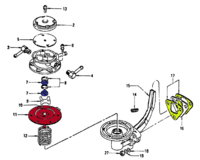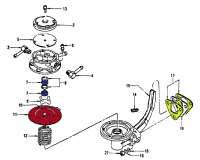
For those of us with original fuel pumps on our 240 and 260Zs, those pumps are now at least 35 years old. Obviously, if they haven't yet been replaced, the time of need can't be far away. In most cases, the obvious answer is to simply replace the pump, either with a new mechanical pump or convert to a modern electric pump.
But the original pumps were designed to be rebuildable. For those of us with restored or original survivor cars, rebuilding the original pump is one way to retain some of the car's originality. It's also surprisingly affordable.
Of course, it's not as easy as it used to be. Many of the parts shown below are no longer available from Nissan. But the critical parts are. The diaphragm and the check valves are the parts that wear, and those are still available, as of February 2009.
[B]17053-E3010[/B] - Diaphram - need one - #11 in [B][COLOR="Red"]red[/COLOR][/B] below [B]17065-21016[/B] - Check valves - need two - #7 in [B][COLOR="Blue"]blue[/COLOR][/B] below [B]17099-E3012[/B] - Pump to head gaskets - need two - #17 in [B][COLOR="Yellow"]yellow[/COLOR][/B] below

In addition to those parts (which cost me $15 with my club discount), you'll want to have a couple of fuel resistant o-rings on hand to replace the seals shown as #8 above. Those seals were NLA, but my little o-ring selection had an appropriate replacement in it. But bear this in mind if you need to depend on getting this done in one operation - the old seals appear to have been cork, and will not be reusable. The new ones I used were square-cut, 3/4" O.D., 5/8" I.D., 1/16" thick. They worked perfectly.
As for the process, it's very simple. I didn't take any pictures, but follow along with the diagram above. Remove the pump from the cylinder head. Then separate the upper and lower body halves (6 screws at the diaphragm seal). Once separated, remove the diaphragm from the lower body. You will need to depress the center of the diaphragm down (against the spring pressure) and then out (away from the cylinder head side) to disconnect it from the cam follower in the lower body half. Once disconnected, remove it carefully so as not to damage the shaft seal (under the spring, not shown above). The replacement diaphragm has a pair of flats on the end of the shaft to ease the installation. Insert it with the flats oriented to the front and rear, push down against the spring while holding the cam follower in the extended position, then turn the diaphragm 90 degrees to engage the shaft into the cam follower.
The valves are both in the upper body. Note that one is face up, the other face down. Make note of which is which, because if you get them wrong, the pump will not work. Remove the retaining plate (#9) after removing the two small screws that clamp it down. Using a pair of needle-nose pliers, remove the valves. (I did mine one at a time to make certain not to mix them up.) Most likely part of the cork seal will come with the valve and the rest will remain in the seat. Carefully (don't damage the housing) remove all of the cork remains. Try not to let any fall into the upper cavity. If it gets in there, you'll want to get it back out to keep it from either clogging the pump valve or being pumped into one of the carbs, depending on which side it fell into. If necessary, remove the top cap (5 screws) to get into the cavity, being careful not to damage the rubber gasket under the top cap.
Install the new o-ring seals, then the valves. Re-install the retainer and screws. Test the correct valve placement by gently blowing into the inlet pipe, and then attempt to suck back on the inlet. If you got the valve correct, you should not be able to suck back on it, but blowing through should be easy. The outlet pipe should be the opposite.
To re-combine the two body halves, first make certain that the screw holes in the diaphragm are pretty much lined up with the holes in the lower body. Operate the cam follower arm to pull the diaphragm down flush, then set the upper body in place and secure it with one of the screws. (A third hand can be handy here. Another option would be to re-install the lower body back on the cylinder head and turning the engine by hand until the diaphragm is pulled down.) Continue with the other 5 screws, don't over-tighten them. Once assembled, operate the cam follower arm a few times, you should be able to hear it pumping air.
Clean both sides of the pump spacer (#16) before installing the new gaskets (#17). Bolt it back to the cylinder head, attach the fuel lines and you are done.
This will work well as long as the diaphragm and valves are still available. Another option for people bent on originality might be to purchase a brand new Kyosan Denki pump and transfer all its new parts into the original body. A bit more expensive, but perhaps worth it for some people.





Recommended Comments
There are no comments to display.
Create an account or sign in to comment
You need to be a member in order to leave a comment
Create an account
Sign up for a new account in our community. It's easy!
Register a new accountSign in
Already have an account? Sign in here.
Sign In Now